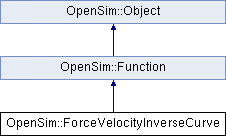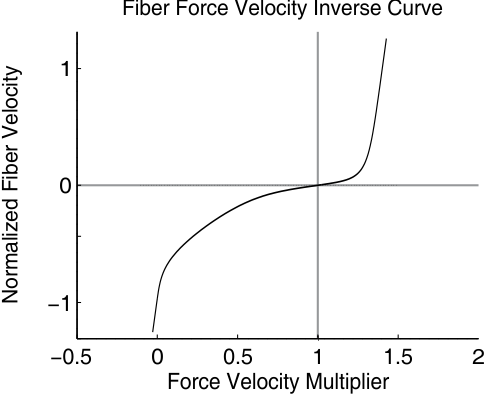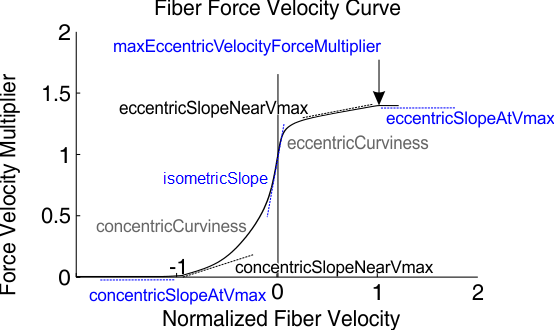|
| | ForceVelocityInverseCurve () |
| | The default constructor creates an inverse force-velocity curve using the default property values and assigns a default name. More...
|
| |
| | ForceVelocityInverseCurve (double concentricSlopeAtVmax, double concentricSlopeNearVmax, double isometricSlope, double eccentricSlopeAtVmax, double eccentricSlopeNearVmax, double maxEccentricVelocityForceMultiplier, double concentricCurviness, double eccentricCurviness) |
| | Constructs an inverse force-velocity curve using the provided parameters and assigns a default name. More...
|
| |
| double | getConcentricSlopeAtVmax () const |
| |
| double | getConcentricSlopeNearVmax () const |
| |
| double | getIsometricSlope () const |
| |
| double | getEccentricSlopeAtVmax () const |
| |
| double | getEccentricSlopeNearVmax () const |
| |
| double | getMaxEccentricVelocityForceMultiplier () const |
| |
| double | getConcentricCurviness () const |
| |
| double | getEccentricCurviness () const |
| |
| void | setCurveShape (double aConcentricSlopeAtVmax, double aConcentricSlopeNearVmax, double aIsometricSlope, double aEccentricSlopeAtVmax, double aEccentricSlopeNearVmax, double aMaxForceMultiplier) |
| |
| void | setConcentricCurviness (double aConcentricCurviness) |
| |
| void | setEccentricCurviness (double aEccentricCurviness) |
| |
| double | calcValue (const SimTK::Vector &x) const override |
| | Implement the generic OpenSim::Function interface. More...
|
| |
| double | calcValue (double aForceVelocityMultiplier) const |
| | Evaluates the inverse force-velocity curve at a force-velocity multiplier value of 'aForceVelocityMultiplier'. More...
|
| |
| double | calcDerivative (double aForceVelocityMultiplier, int order) const |
| | Calculates the derivative of the inverse force-velocity curve with respect to the force-velocity multiplier. More...
|
| |
| SimTK::Vec2 | getCurveDomain () const |
| | Returns a SimTK::Vec2 containing the lower (0th element) and upper (1st element) bounds on the domain of the curve. More...
|
| |
| void | printMuscleCurveToCSVFile (const std::string &path) |
| | Generates a .csv file with a name that matches the curve name (e.g., "bicepsfemoris_ForceVelocityInverseCurve.csv"). More...
|
| |
| void | ensureCurveUpToDate () |
| |
|
These are the serializable properties associated with this class.
|
| | OpenSim_DECLARE_PROPERTY (concentric_slope_at_vmax, double,"Slope of force-velocity curve at the maximum normalized concentric (shortening) velocity (normalized velocity of -1)") |
| |
| | OpenSim_DECLARE_PROPERTY (concentric_slope_near_vmax, double,"Slope of force-velocity curve just before reaching concentric_slope_at_vmax") |
| |
| | OpenSim_DECLARE_PROPERTY (isometric_slope, double,"Slope of force-velocity curve at isometric (normalized velocity of 0)") |
| |
| | OpenSim_DECLARE_PROPERTY (eccentric_slope_at_vmax, double,"Slope of force-velocity curve at the maximum normalized eccentric (lengthening) velocity (normalized velocity of 1)") |
| |
| | OpenSim_DECLARE_PROPERTY (eccentric_slope_near_vmax, double,"Slope of force-velocity curve just before reaching eccentric_slope_at_vmax") |
| |
| | OpenSim_DECLARE_PROPERTY (max_eccentric_velocity_force_multiplier, double,"Value of force-velocity curve at the maximum normalized eccentric contraction velocity") |
| |
| | OpenSim_DECLARE_PROPERTY (concentric_curviness, double,"Shape of concentric branch of force-velocity curve, from linear (0) to maximal curve (1)") |
| |
| | OpenSim_DECLARE_PROPERTY (eccentric_curviness, double,"Shape of eccentric branch of force-velocity curve, from linear (0) to maximal curve (1)") |
| |
| | Function () |
| |
| | Function (const Function &aFunction) |
| |
| virtual | ~Function () |
| |
| virtual void | init (Function *aFunction) |
| |
| Function & | operator= (const Function &aFunction) |
| |
| virtual double | calcDerivative (const std::vector< int > &derivComponents, const SimTK::Vector &x) const |
| | Calculate a partial derivative of this function at a particular point. More...
|
| |
| virtual int | getArgumentSize () const |
| | Get the number of components expected in the input vector. More...
|
| |
| virtual int | getMaxDerivativeOrder () const |
| | Get the maximum derivative order this Function object can calculate. More...
|
| |
| virtual | ~Object () |
| | Virtual destructor for cleanup. More...
|
| |
| virtual Object * | clone () const =0 |
| | Create a new heap-allocated copy of the concrete object to which this Object refers. More...
|
| |
| virtual const std::string & | getConcreteClassName () const =0 |
| | Returns the class name of the concrete Object-derived class of the actual object referenced by this Object, as a string. More...
|
| |
| virtual const VisibleObject * | getDisplayer () const |
| | Methods to support making the object displayable in the GUI or Visualizer Implemented only in few objects. More...
|
| |
| virtual VisibleObject * | updDisplayer () |
| | get Non const pointer to VisibleObject More...
|
| |
| bool | isEqualTo (const Object &aObject) const |
| | Equality operator wrapper for use from languages not supporting operator overloading. More...
|
| |
| Object & | operator= (const Object &aObject) |
| | Copy assignment copies he base class fields, including the properties. More...
|
| |
| virtual bool | operator== (const Object &aObject) const |
| | Determine if two objects are equal. More...
|
| |
| virtual bool | operator< (const Object &aObject) const |
| | Provide an ordering for objects so they can be put in sorted containers. More...
|
| |
| void | setName (const std::string &name) |
| | Set the name of the Object. More...
|
| |
| const std::string & | getName () const |
| | Get the name of this Object. More...
|
| |
| void | setDescription (const std::string &description) |
| | Set description, a one-liner summary. More...
|
| |
| const std::string & | getDescription () const |
| | Get description, a one-liner summary. More...
|
| |
| const std::string & | getAuthors () const |
| | Get Authors of this Object. More...
|
| |
| void | setAuthors (const std::string &authors) |
| | Set Authors of this object, call this method in your constructor if needed. More...
|
| |
| const std::string & | getReferences () const |
| | Get references or publications to cite if using this object. More...
|
| |
| void | setReferences (const std::string &references) |
| | Set references or publications to cite if using this object. More...
|
| |
| int | getNumProperties () const |
| | Determine how many properties are stored with this Object. More...
|
| |
| const AbstractProperty & | getPropertyByIndex (int propertyIndex) const |
| | Get a const reference to a property by its index number, returned as an AbstractProperty. More...
|
| |
| AbstractProperty & | updPropertyByIndex (int propertyIndex) |
| | Get a writable reference to a property by its index number, returned as an AbstractProperty. More...
|
| |
| bool | hasProperty (const std::string &name) const |
| | Return true if this Object has a property of any type with the given name, which must not be empty. More...
|
| |
| const AbstractProperty & | getPropertyByName (const std::string &name) const |
| | Get a const reference to a property by its name, returned as an AbstractProperty. More...
|
| |
| AbstractProperty & | updPropertyByName (const std::string &name) |
| | Get a writable reference to a property by its name, returned as an AbstractProperty. More...
|
| |
| template<class T > |
| bool | hasProperty () const |
| | Return true if this Object contains an unnamed, one-object property that contains objects of the given template type T. More...
|
| |
| template<class T > |
| const Property< T > & | getProperty (const PropertyIndex &index) const |
| | Get property of known type Property<T> as a const reference; the property must be present and have the right type. More...
|
| |
| template<class T > |
| Property< T > & | updProperty (const PropertyIndex &index) |
| | Get property of known type Property<T> as a writable reference; the property must be present and have the right type. More...
|
| |
| void | setObjectIsUpToDateWithProperties () |
| | When an object is initialized using the current values of its properties, it can set a flag indicating that it is up to date. More...
|
| |
| bool | isObjectUpToDateWithProperties () const |
| | Returns true if no property's value has changed since the last time setObjectIsUpToDateWithProperties() was called. More...
|
| |
| void | readObjectFromXMLNodeOrFile (SimTK::Xml::Element &objectElement, int versionNumber) |
| | We're given an XML element from which we are to populate this Object. More...
|
| |
| virtual void | updateFromXMLNode (SimTK::Xml::Element &objectElement, int versionNumber) |
| | Use this method to deserialize an object from a SimTK::Xml::Element. More...
|
| |
| virtual void | updateXMLNode (SimTK::Xml::Element &parent) |
| | Serialize this object into the XML node that represents it. More...
|
| |
| bool | getInlined () const |
| | Inlined means an in-memory Object that is not associated with an XMLDocument. More...
|
| |
| void | setInlined (bool aInlined, const std::string &aFileName="") |
| | Mark this as inlined or not and optionally provide a file name to associate with the new XMLDocument for the non-inline case. More...
|
| |
| std::string | getDocumentFileName () const |
| | If there is a document associated with this object then return the file name maintained by the document. More...
|
| |
| void | setAllPropertiesUseDefault (bool aUseDefault) |
| |
| bool | print (const std::string &fileName) |
| | Write this Object into an XML file of the given name; conventionally the suffix to use is ".osim". More...
|
| |
| std::string | dump (bool dumpName=false) |
| | dump the XML representation of this Object into an std::string and return it. More...
|
| |
| void | clearObjectIsUpToDateWithProperties () |
| | For testing or debugging purposes, manually clear the "object is up to
date with respect to properties" flag. More...
|
| |
| virtual bool | isA (const char *type) const |
| | The default implementation returns true only if the supplied string is "Object"; each Object-derived class overrides this to match its own class name. More...
|
| |
| const std::string & | toString () const |
| | Wrapper to be used on Java side to display objects in tree; this returns just the object's name. More...
|
| |
| PropertySet & | getPropertySet () |
| | OBSOLETE: Get a reference to the PropertySet maintained by the Object. More...
|
| |
| const PropertySet & | getPropertySet () const |
| |
This class serves as a serializable ForceVelocityInverseCurve for use in equilibrium muscle models.
The inverse force-velocity curve is dimensionless: force is normalized to maximum isometric force and velocity is normalized to the maximum muscle contraction velocity (vmax), where vmax is expressed in units of optimal_fiber_lengths per second. Negative normalized velocities correspond to concentric contraction (i.e., shortening). The inverse force-velocity curve is constructed from 8 properties, which are identical to those used to construct the corresponding force-velocity curve. See ForceVelocityCurve for descriptions of these parameters.
- Parameters
-
| concentricSlopeAtVmax | An exception will be thrown if this parameter is set to 0. |
| concentricSlopeNearVmax | An exception will be thrown if this parameter is set to 0. |
| isometricSlope | |
| eccentricSlopeAtVmax | An exception will be thrown if this parameter is set to 0. |
| eccentricSlopeNearVmax | An exception will be thrown if this parameter is set to 0. |
| maxEccentricVelocityForceMultiplier | |
| concentricCurviness | |
| eccentricCurviness |
|
Conditions
1a) 0 < concentricSlopeAtVmax < 1
1b) concentricSlopeAtVmax < concentricSlopeNearVmax < 1
2a) 1 < isometricSlope
2b) (maxEccentricVelocityForceMultiplier-1)/1 < isometricSlope
3) 0 < eccentricSlopeAtVmax < (maxEccentricVelocityForceMultiplier-1)/1
4) 1 < maxEccentricVelocityForceMultiplier
5) 0 <= concentricCurviness <= 1
6) 0 <= eccentricCurviness <= 1
Default Parameter Values
concentricSlopeAtVmax .................. 0.1
concentricSlopeNearVmax ................ 0.25
isometricSlope ......................... 5.0
eccentricSlopeAtVmax ................... 0.1
eccentricSlopeNearVmax ................. 0.15
maxEccentricVelocityForceMultiplier .... 1.4
concentricCurviness .................... 0.6
eccentricCurviness ..................... 0.9
Example
double fvInvVal = fvInvCurve.calcValue(1.0);
double dfvInvVal = fvInvCurve.calcDerivative(1.0, 1);
Note that this object should be updated through the set methods provided. These set methods will take care of rebuilding the curve correctly. If you modify the properties directly, the curve will not be rebuilt, and upon calling a function like calcValue, calcDerivative, or printCurveToCSVFile, an exception will be thrown because the curve is out-of-date with its properties.
- Author
- Matt Millard

 Public Member Functions inherited from OpenSim::Function
Public Member Functions inherited from OpenSim::Function Public Member Functions inherited from OpenSim::Object
Public Member Functions inherited from OpenSim::Object Static Public Member Functions inherited from OpenSim::Function
Static Public Member Functions inherited from OpenSim::Function Static Public Attributes inherited from OpenSim::Object
Static Public Attributes inherited from OpenSim::Object Protected Member Functions inherited from OpenSim::Function
Protected Member Functions inherited from OpenSim::Function Protected Attributes inherited from OpenSim::Function
Protected Attributes inherited from OpenSim::Function Related Functions inherited from OpenSim::Object
Related Functions inherited from OpenSim::Object
